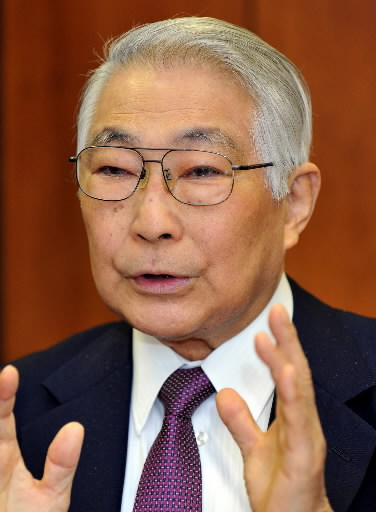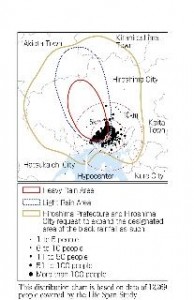RERF data issue
Jan. 19, 2012
Black rain: Call for open research
by Kenji Namba, Senior Staff Writer
Amid the focus on the issue of low-level and internal exposure to radiation resulting from the accident at the nuclear power plant in Fukushima, another look should be taken at the activities of the Radiation Effects Research Foundation (RERF). The foundation, a cooperative Japan-U.S. research organization with offices in Hiroshima and Nagasaki, studies the effects of the radiation from the atomic bombings. Its predecessor, the Atomic Bomb Casualty Commission (ABCC), was established 65 years ago. Over the years the foundation’s research has focused primarily on the effects of radiation on the human body, but recently this basic approach has been called into question. In particular, the issue of the data on the black rain that emerged last fall has raised doubts among atomic bomb survivors and local governments, who have cooperated in the foundation’s research, about exactly for whom and for what purpose their research has been conducted.
Follow-up study not released
High barriers to gaining permission for use
On December 20 of last year, RERF released a distribution map it had prepared based on data from a survey conducted in the 1950s by the foundation’s forerunner, the ABCC, of 14,633 people in Hiroshima and 904 in Nagasaki who said they had been exposed to the black rain after the atomic bombings.
But the map that was released simply charted the locations where people said they had been exposed to the black rain, while place names and numbers of people were noted on a separate sheet. No analysis was included, and no distinction was made between the area for which the central government currently provides assistance and other areas.
Some of the research was based on RERF’s Life Span Study, which included follow-up studies of the health and deaths of 12,269 survivors from Hiroshima and 853 from Nagasaki. This data could be used to confirm a connection with the black rain, which contained radioactive materials. But RERF has not expressed any intention of either releasing or analyzing the data.
The fact that RERF had data on the black rain came to light on November 8 after the late September discovery by a doctor in Nagasaki of a report that was written at the Oak Ridge National Laboratory in the U.S. in 1972.
The cities of Hiroshima and Nagasaki have both requested the expansion of the designated black rain area, and citizens’ groups have complained of health problems as a result of exposure to the black rain. So since the discovery of the report they have asked RERF to release and analyze the data. Amid the holding of review sessions to consider the expansion of the black rain area designated by the Health, Labor and Welfare Ministry, it must be said that the release of the distribution map at the end of last year was too limited and too slow.
Cooperation with U.S. policy
This calls to mind RERF’s participation in the research plan of the U.S. National Institute of Allergies and Infectious Diseases on “Medical Countermeasures Against Radiological and Nuclear Threats.” RERF’s participation in the plan was decided on in the fall of 2009 despite the opposition of local atomic bomb survivor groups and some members of a local liaison council that worked with RERF who felt that it was unacceptable to use materials and samples from atomic bomb survivors for research based on the premise of a nuclear attack.
RERF made no effort to respond directly to the wishes of local governments, residents or atomic bomb survivors. Meanwhile RERF’s stance of simply going along with a policy that may be involved, either directly or indirectly, with U.S. nuclear policy, is evident.
"What’s past is past”
With regard to the release of its data, RERF stresses that outside researchers may use it if they follow prescribed procedures. But this can not be taken at face value because in order for use of the data to be approved, the research plan must be approved not only by an internal committee but also by experts with international authority.
In fact, it has been revealed that while the ABCC and RERF planned to conduct research on the effects of residual radiation on persons who entered Hiroshima and Nagasaki after the bombings it was never carried out, and a health survey on internal radiation was canceled partway through.
While researchers in Hiroshima, Nagasaki and other cities in Japan look to RERF for its research, many have called for the foundation to be a more autonomous, open research organization.
Among those who hold this opinion is Megu Otaki, a professor of statistics at Hiroshima University’s Research Institute for Radiation Biology and Medicine, who analyzed the black rain surveys conducted by Hiroshima’s city and prefectural governments. With regard to the Oak Ridge report, which led to the discovery of the black rain data, Prof. Otaki said, “What is most significant is the fact that 40 years ago someone at the ABCC focused on the effects of the black rain on the human body.” He went on, “What’s past is past. I want to see what sort of stance RERF will take on the black rain data from now on.”
An interview with Toshiteru Okubo, chairman of the Radiation Effects Research Foundation
Deviations make analysis difficult
The Chugoku Shimbun talked with Toshiteru Okubo, chairman of the Radiation Effects Research Foundation, about exposure to low doses of radiation and other issues. The following are excerpts from that interview.
How has RERF been involved in the issue of exposure to low doses of radiation?
RERF’s research related to the atomic bombings is based on historical data. We can no longer get new information from the time of the bombings. The accident at the nuclear power plant in Fukushima doesn’t change that fact.
People say that RERF is asserting that exposure to low doses of radiation has no effect on the human body, but that is a misconception. There is quite a bit of data on exposure to low doses of radiation, but it is insufficient and inconclusive. I would like people to understand that our research is ongoing.
What about residual radiation and internal exposure?
It’s no longer possible to get records of the movements of individual atomic bomb survivors, so we can’t conduct research on that even if we want to.
Some people have suggested that RERF’s data underestimates the effects of radiation on the human body.
We conduct our research based on the amount of radiation people were directly exposed to and provide data that is useful in setting radiation protection standards. Relative to our estimates of the doses of residual radiation and internal exposure, any errors are small. If anything, we are overestimating the effects of radiation.
How did RERF respond to the accident in Fukushima?
In response to a request, we sent people to Fukushima to cooperate in the preparation of a questionnaire for the health survey. We are offering advice on the sorts of specific questions that should be asked.
I’ve heard that RERF is reviewing its research.
In 2007 we set up a “Radiation Dose Committee.” The idea was for this committee to review our data so we could create a more accurate record of the locations at which of each of the individuals in our Life Span Study group, which serves as the basis of our research, were exposed to the atomic bombing and to look into the differences in the effects on the health of those who were exposed to the black rain and those who were not.
This was before the Oak Ridge report was found, right?
The report was found around the time we finished entering our data. Even before that people had asked for our opinion on the black rain. We felt we needed to look into it because we had data.
Is the research moving forward?
We have not yet begun the analysis. In our case, in order to start any research we must first consult with an internal committee and then seek the opinion of an outside international expert.
What is the outlook?
It may be difficult. In any case there are too many deviations in the data.
What do you mean by “deviations”?
The subjects of our survey always identify the location at which they were exposed to the atomic bombing on an axis. The further away from the hypocenter, the lower the sampling ratio is. The people who were close to the hypocenter, who represent a high percentage of the sample, were directly exposed to the bombing and received a high dose of radiation in the first place, so even if they were exposed to the black rain it is difficult to determine the effect it had.
Still, it seems unthinkable that you would choose not to analyze the data.
I don’t think we can carry it out as a formal research project, but I would like to present findings in some form.
Will the data be released?
We will provide the data to outside researchers after they have completed prescribed procedures if we can confirm that the research would be meaningful.
Toshiteru Okubo
Born in Tokyo in 1939. Graduate of the Keio University School of Medicine. After serving in various posts including professor and president of the University of Occupational and Environmental Health, Japan, became vice chairman of the Radiation Effects Research Foundation in April 2005. Assumed his current post as chairman in July of the same year.
Oak Ridge Report
The Oak Ridge Report is an English-language report that was discovered on the Internet last fall by Koya Honda, a doctor in Nagasaki who is working on the black rain issue. The report was co-authored by the manager of the research department at the then Atomic Bomb Casualty Commission (ABCC) and a researcher at the Oak Ridge National Laboratory in the U.S. in 1972. Based on data collected by the ABCC, the report states that people exposed to the black rain suffered acute symptoms as a result. In the course of assessing this report, it was found that the Radiation Effects Research Foundation, the successor to the ABCC, had data on more than 10,000 people who were exposed to the black rain.
(Originally published on January 16, 2012)









